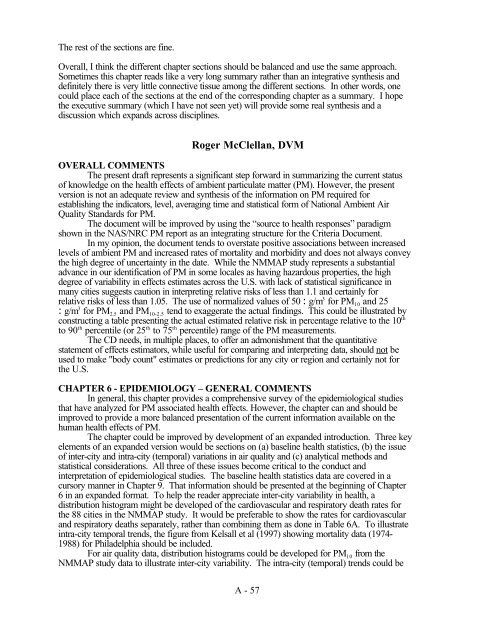Review of the Air Quality Criteria Document for Particulate Matter
Review of the Air Quality Criteria Document for Particulate Matter
Review of the Air Quality Criteria Document for Particulate Matter
- No tags were found...
You also want an ePaper? Increase the reach of your titles
YUMPU automatically turns print PDFs into web optimized ePapers that Google loves.
The rest <strong>of</strong> <strong>the</strong> sections are fine.Overall, I think <strong>the</strong> different chapter sections should be balanced and use <strong>the</strong> same approach.Sometimes this chapter reads like a very long summary ra<strong>the</strong>r than an integrative syn<strong>the</strong>sis anddefinitely <strong>the</strong>re is very little connective tissue among <strong>the</strong> different sections. In o<strong>the</strong>r words, onecould place each <strong>of</strong> <strong>the</strong> sections at <strong>the</strong> end <strong>of</strong> <strong>the</strong> corresponding chapter as a summary. I hope<strong>the</strong> executive summary (which I have not seen yet) will provide some real syn<strong>the</strong>sis and adiscussion which expands across disciplines.Roger McClellan, DVMOVERALL COMMENTSThe present draft represents a significant step <strong>for</strong>ward in summarizing <strong>the</strong> current status<strong>of</strong> knowledge on <strong>the</strong> health effects <strong>of</strong> ambient particulate matter (PM). However, <strong>the</strong> presentversion is not an adequate review and syn<strong>the</strong>sis <strong>of</strong> <strong>the</strong> in<strong>for</strong>mation on PM required <strong>for</strong>establishing <strong>the</strong> indicators, level, averaging time and statistical <strong>for</strong>m <strong>of</strong> National Ambient <strong>Air</strong><strong>Quality</strong> Standards <strong>for</strong> PM.The document will be improved by using <strong>the</strong> “source to health responses” paradigmshown in <strong>the</strong> NAS/NRC PM report as an integrating structure <strong>for</strong> <strong>the</strong> <strong>Criteria</strong> <strong>Document</strong>.In my opinion, <strong>the</strong> document tends to overstate positive associations between increasedlevels <strong>of</strong> ambient PM and increased rates <strong>of</strong> mortality and morbidity and does not always convey<strong>the</strong> high degree <strong>of</strong> uncertainty in <strong>the</strong> date. While <strong>the</strong> NMMAP study represents a substantialadvance in our identification <strong>of</strong> PM in some locales as having hazardous properties, <strong>the</strong> highdegree <strong>of</strong> variability in effects estimates across <strong>the</strong> U.S. with lack <strong>of</strong> statistical significance inmany cities suggests caution in interpreting relative risks <strong>of</strong> less than 1.1 and certainly <strong>for</strong>relative risks <strong>of</strong> less than 1.05. The use <strong>of</strong> normalized values <strong>of</strong> 50 :g/m 3 <strong>for</strong> PM 10 and 25:g/m 3 <strong>for</strong> PM 2.5 and PM 10-2.5 tend to exaggerate <strong>the</strong> actual findings. This could be illustrated byconstructing a table presenting <strong>the</strong> actual estimated relative risk in percentage relative to <strong>the</strong> 10 thto 90 th percentile (or 25 th to 75 th percentile) range <strong>of</strong> <strong>the</strong> PM measurements.The CD needs, in multiple places, to <strong>of</strong>fer an admonishment that <strong>the</strong> quantitativestatement <strong>of</strong> effects estimators, while useful <strong>for</strong> comparing and interpreting data, should not beused to make "body count" estimates or predictions <strong>for</strong> any city or region and certainly not <strong>for</strong><strong>the</strong> U.S.CHAPTER 6 - EPIDEMIOLOGY – GENERAL COMMENTSIn general, this chapter provides a comprehensive survey <strong>of</strong> <strong>the</strong> epidemiological studiesthat have analyzed <strong>for</strong> PM associated health effects. However, <strong>the</strong> chapter can and should beimproved to provide a more balanced presentation <strong>of</strong> <strong>the</strong> current in<strong>for</strong>mation available on <strong>the</strong>human health effects <strong>of</strong> PM.The chapter could be improved by development <strong>of</strong> an expanded introduction. Three keyelements <strong>of</strong> an expanded version would be sections on (a) baseline health statistics, (b) <strong>the</strong> issue<strong>of</strong> inter-city and intra-city (temporal) variations in air quality and (c) analytical methods andstatistical considerations. All three <strong>of</strong> <strong>the</strong>se issues become critical to <strong>the</strong> conduct andinterpretation <strong>of</strong> epidemiological studies. The baseline health statistics data are covered in acursory manner in Chapter 9. That in<strong>for</strong>mation should be presented at <strong>the</strong> beginning <strong>of</strong> Chapter6 in an expanded <strong>for</strong>mat. To help <strong>the</strong> reader appreciate inter-city variability in health, adistribution histogram might be developed <strong>of</strong> <strong>the</strong> cardiovascular and respiratory death rates <strong>for</strong><strong>the</strong> 88 cities in <strong>the</strong> NMMAP study. It would be preferable to show <strong>the</strong> rates <strong>for</strong> cardiovascularand respiratory deaths separately, ra<strong>the</strong>r than combining <strong>the</strong>m as done in Table 6A. To illustrateintra-city temporal trends, <strong>the</strong> figure from Kelsall et al (1997) showing mortality data (1974-1988) <strong>for</strong> Philadelphia should be included.For air quality data, distribution histograms could be developed <strong>for</strong> PM 10 from <strong>the</strong>NMMAP study data to illustrate inter-city variability. The intra-city (temporal) trends could beA - 57
















